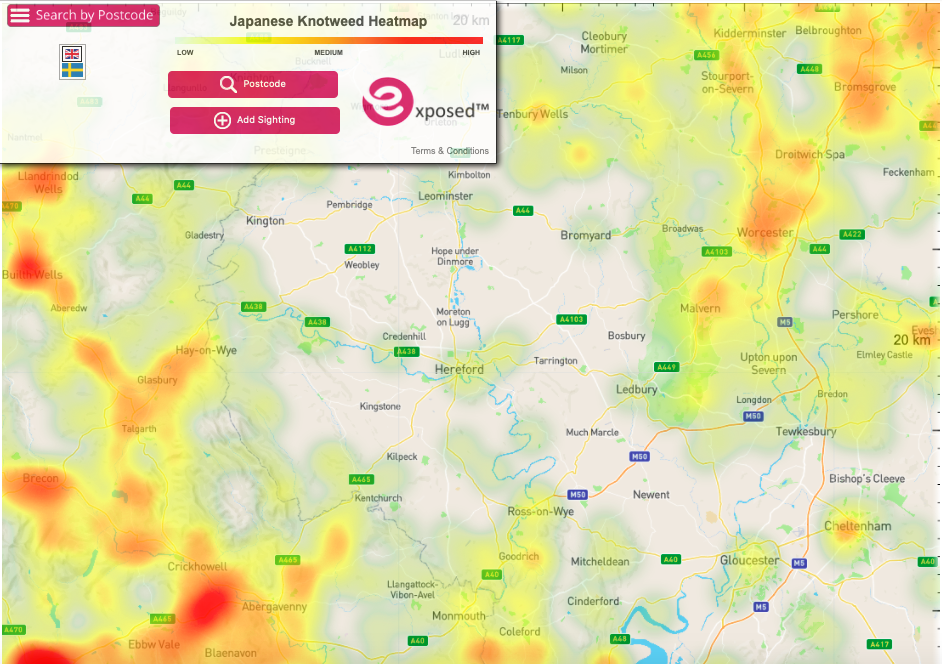Spring 2021 Japanese knotweed hotspots revealed
Goodrich, Ross-on-Wye and Hereford are worst affected locations in Herefordshire
05 May 2021: As the UK’s most invasive plant enters its spring growth phase, Japanese knotweed expert Environet reveals the latest hotspots using data from its interactive online tracker, Exposed: the Japanese Knotweed Heatmap https://environetuk.com/exposed-japanese-knotweed-heat-map>.
Populated with over 54,000 known infestations of Japanese knotweed, charting the spread of the plant across the UK, Exposed informs homeowners and potential homebuyers of the local presence of knotweed and the potential risk to their property. Users can enter a postcode to discover the number of reported knotweed sightings nearby, with hotspots highlighted in yellow or red.
The Herefordshire Japanese knotweed hotspots for 2021 are:
Location
Infestations within 4km radius
Goodrich
12
Ross-on-Wye
11
Hereford
8
Fownhope
6
Following its winter hibernation, knotweed begins to grow in March or April, depending on the local ground temperature, reaching up to 3 metres in height by mid-summer. Homeowners spending more time in their gardens this spring may notice purple or red asparagus-like shoots now emerging from the ground and quickly growing into lush green shrubs with heart or shovel-shaped leaves and pink-flecked stems.
Pushing up through cracks in concrete, driveways, patios, paths, drains and even the cavity walls of our homes, Japanese knotweed can reduce a property’s value by 10% and make it difficult to sell, unless a professional treatment plan is in place with an insurance-backed guarantee to satisfy mortgage lenders. According to Environet’s research, approximately 5% of homes are currently affected, either directly or indirectly (neighbouring an affected property), knocking around £20 billion off UK house prices.
The general public can help in the fight against knotweed by reporting suspicious plants using the heatmap’s ‘Add Sighting’ feature and attaching a photo to be verified by experts.
Mat Day, Environet’s Regional Director for Herefordshire, said: “Knowledge is power when it comes to Japanese knotweed and this heatmap is invaluable to homeowners and buyers who want to assess the risk in their local area. With the stamp duty holiday extended and lockdown restrictions beginning to ease, the property market is busier than ever – but failing to carry out the appropriate checks for knotweed can turn out to be an expensive mistake.
“Despite its fearsome reputation, with professional help, the plant can be dealt with and the value of a property largely restored. I’d urge anyone buying or selling a property, or homeowners wishing to preserve the value of their home, to be vigilant for signs of spring growth and check Exposed to see whether they live in a high-risk area.”
Facts about Japanese knotweed
• Japanese knotweed arrived in the UK in the 1840s, in box number 34 of 40 Chinese and Japanese plant species delivered to Kew Gardens
• Knotweed grows at the incredible rate of around 10cm a day from May until July
• When it is fully grown it can stand up to 3 metres tall
• Approximately £166m is spent each year on treating the plant in the UK
• The Government estimates it would cost £1.5bn to clear the UK of knotweed
• Japanese knotweed can lie dormant but alive under the ground for up to 20 years
• Sniffer dogs are now helping in the fight against knotweed, detecting the unique scent of its rhizome beneath the ground
• Property owners who fail to stop the spread of knotweed on their land can face fines and even a jail sentence under ASBO legislation
To view Japanese knotweed infestations in your area or to report a sighting, visit: https://environetuk.com/exposed-japanese-knotweed-heat-map
(Credit: Environet UK)




